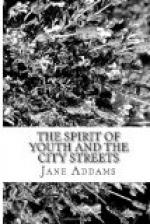When the boy is on the street, however, and is “standing around on the corner” with the gang to which he mysteriously attaches himself, he finds the difficulties of direct untrammeled action almost as great there as they were in the factory, but for an entirely different set of reasons. The necessity so strongly felt in the factory for an outlet to his sudden and furious bursts of energy, his overmastering desire to prove that he could do things “without being bossed all the time,” finds little chance for expression, for he discovers that in whatever really active pursuit he tries to engage, he is promptly suppressed by the police. After several futile attempts at self-expression, he returns to his street corner subdued and so far discouraged that when he has the next impulse to vigorous action he concludes that it is of no use, and sullenly settles back into inactivity. He thus learns to persuade himself that it is better to do nothing, or, as the psychologist would say, “to inhibit his motor impulses.”
When the same boy, as an adult workman, finds himself confronted with an unusual or an untoward condition in his work, he will fall back into this habit of inhibition, of making no effort toward independent action. When “slack times” come, he will be the workman of least value, and the first to be dismissed, calmly accepting his position in the ranks of the unemployed because it will not be so unlike the many hours of idleness and vacuity to which he was accustomed as a boy. No help having been extended to him in the moment of his first irritable revolt against industry, his whole life has been given a twist toward idleness and futility. He has not had the chance of recovery which the school system gives a like rebellious boy in a truant school.
The unjustifiable lack of educational supervision during the first years of factory work makes it quite impossible for the modern educator to offer any real assistance to young people during that trying transitional period between school and industry. The young people themselves who fail to conform can do little but rebel against the entire situation, and the expressions of revolt roughly divide themselves into three classes. The first, resulting in idleness, may be illustrated from many a sad story of a boy or a girl who has spent in the first spurt of premature and uninteresting work, all the energy which should have carried them through years of steady endeavor.
I recall a boy who had worked steadily for two years as a helper in a smelting establishment, and had conscientiously brought home all his wages, one night suddenly announcing to his family that he “was too tired and too hot to go on.” As no amount of persuasion could make him alter his decision, the family finally threatened to bring him into the Juvenile Court on a charge of incorrigibility, whereupon the boy disappeared and such efforts as the family have been able to make in the two years since, have failed to find him. They are convinced that “he is trying a spell of tramping” and wish that they “had let him have a vacation the first summer when he wanted it so bad.” The boy may find in the rough outdoor life the healing which a wise physician would recommend for nervous exhaustion, although the tramp experiment is a perilous one.




